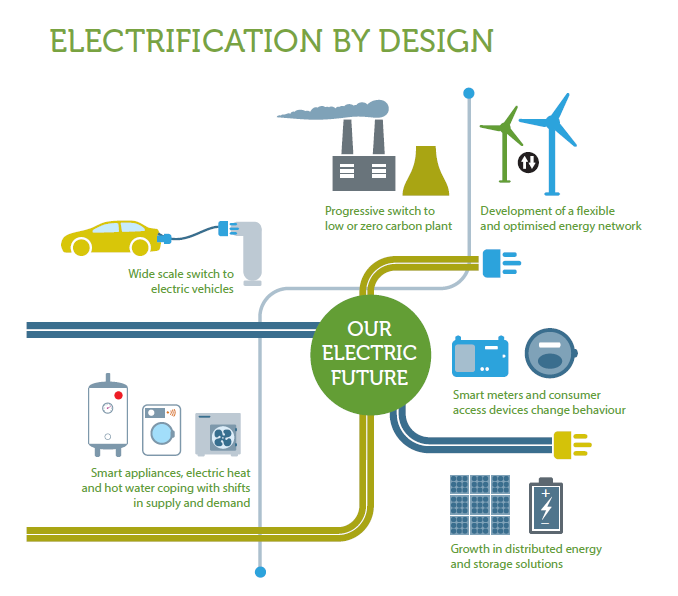We’ve previously looked at the British Electrotechnical and Allied Manufacturers’ Association’s “Guide to Electric Vehicle Infrastructure“. Now they have released a new report which looks at electric vehicles in the context of the “transformation of our energy system”.
BEAMA summarise their “Electrification by Design” report with 6 “market design imperatives”:
Electrification by Design explores simple policy mechanisms and regional structure options to promote wide scale deployment of low to zero carbon electric systems.
-
Electrification is a national need, but optimised, flexible energy systems will be delivered by regions and zones empowered to identify the most appropriate paths.
-
Integrated and innovative finance packages are essential for market transformation.
-
The supply chain must have sufficient capacity to promote sustainable growth.
-
Consumers need confidence that services, systems and devices form part of a structured consumer journey. We need to navigate a critical path to electrification and decarbonisation.
-
Demand Side Response needs concurrent and planned development of regulation, technology and markets.
-
New and innovative ways of purchasing and providing energy services will emerge.
We wholeheartedly agree with BEAMA’s recommendation that:
The first priority is the energy efficiency of buildings
“NegaWatts not MegaWatts” has long been a mantra of ours! Other recommendations regarding transport, energy storage, buildings and energy markets include:
- Implement a mix of smart solutions such as managed charging, reinforcement and infrastructure upgrades to facilitate consumer uptake of EVs
- Future proof the house building programme
- Focus on the value of intelligent control and enable platforms that support interoperable services, systems and devices
- Design markets so that all participants can engage with price signals and allow for market evolution as improved technology emerges
- Keep the market open to new entrants to expand the range of service propositions to consumers
- Co-locate storage, generation and charging at key large charging locations
Looking more closely at the section of the report devoted to electric vehicles, BEAMA have this to say:
A flexible and optimised energy system will balance the introduction of new technologies into buildings with the challenges these new loads can place on the network. This is particularly relevant to the sharp increase in electric vehicle charging infrastructure.
Technology that can perform load management or response functions can be connected to the network or deployed in the home, electric vehicles can be sold to the consumer and charging points installed, but without markets that allow providers to stack revenues and build their consumer propositions the potential value of this technology will never be realised.
I couldn’t have said it better myself! The UK Government is committed to a rapid electrification of road transport, but current energy markets represent a significant barrier to realising the potential of the technology. BEAMA add:
As the rollout of new technology and services continues without the right market conditions, their value is eroded or delayed. This is even without considering the lost upstream value and savings that these services could be providing to other market participants such as focused and planned infrastructure spending and energy management supported by Demand Side Response.
EVs are mentioned once again in the section of the report that discusses “passive consumers”:
Electric vehicle sales are rising rapidly and a well-functioning flexible energy system will reduce the impact of the ‘all electric’ switch to as little as a 5GW peak rise in electricity demand (8%), but only if we have the required level of engagement from consumers; in turn, this means getting the consumer proposition right.
Moving on to the “Transport” section of the report, our views begin to diverge from BEAMA’s slightly. They reiterate their 6th bullet point above:
Technology is likely to enable faster and faster charging rates, and reducing charging times to 5-10 minutes (similar to the time it takes to refuel a petrol or diesel car) could mark a tipping point for consumer interest. Another may be when ongoing innovation in battery technologies allows for a range similar to what is currently available from a tank of petrol or diesel.
Such technological development and deployment could also change the way consumers charge their vehicles, moving to centralised and co-located fast charging alongside or instead of slow charging. This could allow infrastructure investment to be better targeted. Centralising or co-locating the charging infrastructure with generation and storage can alleviate the pressure on local domestic low voltage networks.
Here at V2G UK we agree that “faster and faster charging rates” along major trunk routes are highly desirable, but we also believe that there is a place for the sort of technology summarised in the “artist’s impression” in our banner above. Alleviating the pressure on local domestic low voltage networks through the use of distributed generation and storage co-located with what BEAMA refers to as “slow charging rates”. Having renewable generation and energy storage located at your home or small business provides advantages that having similar, albeit larger and faster, facilities located on the nearest Shell forecourt does not! Particularly if you’re intent on the electrification of heating as well as transport, a topic which BEAMA also discuss at length in their new report.
As you have hopefully gathered by now, realising that vision will require a radical change to the UK’s energy markets, possibly even going beyond the significant changes recommended by BEAMA.

